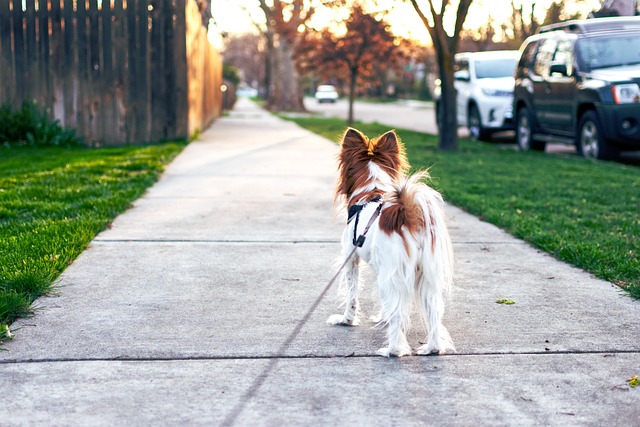Trustworthy Pet Care: Albany’s Friendly Neighborhoods Unveiled

Albany's diverse pet-friendly neighborhoods cater to various budgets and offer dedicated animal spaces in new developments. Reputable pet-sitting…….
Welcome to the world of pet-friendly living, specifically focusing on the vibrant city of Albany. In recent years, there has been a global shift towards creating urban environments that cater to the needs of both humans and their furry companions. Albany, a bustling metropolis known for its rich history and cultural offerings, has embraced this trend, giving rise to several neighborhoods that are truly pet-lovers’ havens. This article aims to explore the various facets of these specialized areas, providing valuable insights for residents, prospective buyers, and urban planners alike. By delving into the definition, significance, and diverse aspects of pet-friendly neighborhoods in Albany, we will uncover why they are not just a passing trend but a crucial component of modern urban development.
A pet-friendly neighborhood in Albany is a residential area that prioritizes the well-being and integration of pets into daily community life. This concept goes beyond simply tolerating animals; it involves designing and maintaining spaces that encourage interaction, exercise, and social engagement between residents and their pets. The core components typically include:
The concept of pet-friendly neighborhoods has evolved over time, driven by changing societal attitudes towards animals and the increasing humanization of pets. Historically, urban planning often overlooked the needs of non-human residents, leading to limited green spaces and restricted access to outdoor areas for pets. However, as awareness grew about the benefits of human-animal bonding and the contributions of pets to mental health and community building, this mindset began to shift.
In Albany, the idea of pet-friendly neighborhoods gained traction in the early 2010s, fueled by a growing pet-owning population and a desire to create more inclusive public spaces. The city’s commitment to promoting a high quality of life for all residents, including their four-legged friends, has led to the development of several pioneering areas. These neighborhoods are not just about convenience; they contribute to a sense of community, encourage physical activity, and enhance the overall well-being of pet owners and non-owners alike.
The trend of creating pet-friendly spaces is a global phenomenon, with cities worldwide recognizing the value of catering to their canine (and feline) citizens. Albany’s approach has drawn inspiration from successful models in other metropolitan areas, such as Portland, Oregon, known for its dog-friendly culture and extensive network of off-leash parks. Similarly, London, England, has embraced pet-friendliness with dedicated cat cafes and dog-friendly public spaces, reflecting a growing trend across Europe.
Several trends are shaping the future of pet-friendly neighborhoods:
The implementation of pet-friendly initiatives varies across regions due to cultural differences, climate, and urban planning practices:
| Region | Common Features | Unique Aspects |
|—|—|—|
| North America (USA & Canada) | Dog parks, pet-friendly housing, veterinary clinics | Cat cafes, dog walking tours, pet-centric festivals |
| Europe (UK, Germany, France) | Green spaces, pet-friendly cafes, public transport | Dog-friendly public events, pet adoption programs |
| Asia (Japan, South Korea) | Pet hotels, indoor play areas, pet insurance | Traditional pet rituals, community gardens |
| Australia & New Zealand | Beach access, outdoor recreation, pet microchipping | Pet-focused tourism, wildlife conservation efforts |
Pet-friendly neighborhoods have a significant impact on the local real estate market. According to a recent study by the National Association of Realtors (NAR), homes listed as pet-friendly sell faster and at higher prices than those without this designation. In Albany, this trend is evident, with certain neighborhoods experiencing rapid appreciation due to their pet-centric amenities.
Investors are increasingly recognizing the potential of these areas, leading to a surge in development projects catering to pet owners. This includes the construction of specialized housing, pet-focused retail spaces, and recreational facilities, contributing to economic growth and diversification.
Pet-friendly neighborhoods contribute to local economies in several ways:
The Internet of Things (IoT) has revolutionized pet care with smart home automation systems. These devices allow owners to remotely monitor their pets’ activities, feeding schedules, and health metrics using mobile apps. For example, smart feeders can dispense food at specific times or based on activity levels, ensuring pets eat responsibly. Similarly, GPS tracking collars provide real-time location data, offering peace of mind for anxious owners.
Wearable technology for pets is gaining popularity. These devices track physical activities, sleep patterns, and vital signs, providing valuable insights into an animal’s overall health. Some advanced wearables even detect early signs of illness, allowing for prompt veterinary intervention. This technology empowers owners to make informed decisions about their pets’ well-being.
Mobile applications cater specifically to pet owners, offering a range of services:
The development and management of pet-friendly neighborhoods in Albany are guided by a combination of local policies, regulations, and legislative frameworks:
Key policies and their impact include:
Despite the numerous benefits, pet-friendly neighborhoods face several challenges:
Proactive solutions include:
Location: South End, Albany
Characteristics: This vibrant neighborhood boasts multiple dog parks, cat trees in community gardens, and a dedicated pet supply store. Regular pet adoption events and dog walks bring residents together.
Success Factors:
Location: West Side, Albany
Characteristics: Known for its extensive network of green spaces, this neighborhood has designated off-leash areas for dogs and a cat cafe. A mobile pet grooming service operates within the community.
Lessons Learned:
Location: Downtown Core, Albany (Revitalization Project)
Characteristics: An old industrial area underwent transformation into a vibrant pet-friendly hub with lofts converted into pet-centric apartments, a shared dog park, and pet-focused retail.
Key Takeaways:
The future of pet-friendly neighborhoods in Albany looks promising, with several potential developments:
To ensure the continued success and growth of these neighborhoods:
Pet-friendly neighborhoods in Albany represent a harmonious blend of urban living, animal welfare, and community engagement. As the global trend towards pet-centric spaces continues to gain traction, these specialized areas offer unique advantages for residents and contribute significantly to the city’s overall appeal. By embracing innovation, fostering community, and addressing challenges head-on, Albany sets an example for other cities worldwide, demonstrating that prioritizing pets enhances the quality of life for all.
Q: Are pet-friendly neighborhoods suitable for everyone?
A: Absolutely! These neighborhoods cater to a diverse range of residents, including families, singles, and seniors. While some areas may have specific design considerations, inclusive planning ensures that everyone can enjoy the benefits, and adaptations can be made as needed.
Q: How do pet-friendly initiatives impact local businesses?
A: Pet-focused businesses thrive in these neighborhoods, attracting customers and boosting the local economy. From specialized retailers to pet-centric cafes and services, these enterprises contribute to a vibrant urban environment.
Q: Can pets help with social connections in these communities?
A: Certainly! Pets serve as excellent icebreakers, facilitating conversations and fostering social bonds between neighbors. Organized events and activities further strengthen the sense of community, creating a supportive network for both people and animals.
Q: What role do local governments play in developing pet-friendly neighborhoods?
A: Local governments provide essential infrastructure, zoning support, and policy frameworks to guide development. They also oversee public spaces, ensuring they meet the needs of pet owners and other residents alike. Collaboration between government bodies and community groups is key to successful implementation.
Q: Are there any challenges in maintaining these neighborhoods?
A: As with any urban planning initiative, challenges exist. Balancing noise levels, managing waste disposal, and addressing allergies are ongoing considerations. However, proactive community engagement and thoughtful policy-making can mitigate these issues effectively.

Albany's diverse pet-friendly neighborhoods cater to various budgets and offer dedicated animal spaces in new developments. Reputable pet-sitting…….

Albany's pet-friendly culture thrives with walkable parks, green spaces, and districts catering to dogs and cats. Homeowners associations permit…….

Pet-friendly neighborhoods in Albany offer a unique blend of urban living and outdoor recreation. With well-manicured green spaces, apartment complexe…….

Albany's downtown area boasts vibrant, pet-friendly neighborhoods with diverse accommodations for cats and dogs. New developments offer tailored…….

Albany boasts several pet-friendly neighborhoods with charming streetscapes, parks, and flexible renting guidelines. These areas prioritize safety, gr…….

Albany's downtown area offers a variety of pet-friendly hotels with dedicated spaces and services for pets, as well as welcoming neighborhoods an…….

Pet owners in Albany, NY, can find suitable housing through understanding local laws and exploring diverse neighborhoods. The city offers a range of p…….

Pet-friendly neighborhoods in Albany offer easy access to top-rated veterinary clinics and thriving pet communities. These areas, like North End and D…….

Albany boasts diverse pet-friendly neighborhoods with ample green spaces, events, and amenities. From historic North End to dog-friendly Downtown, eac…….

Albany, NY, boasts pet-friendly neighborhoods with ample green spaces and inclusive communities. The city caters to dogs, cats, and their owners throu…….